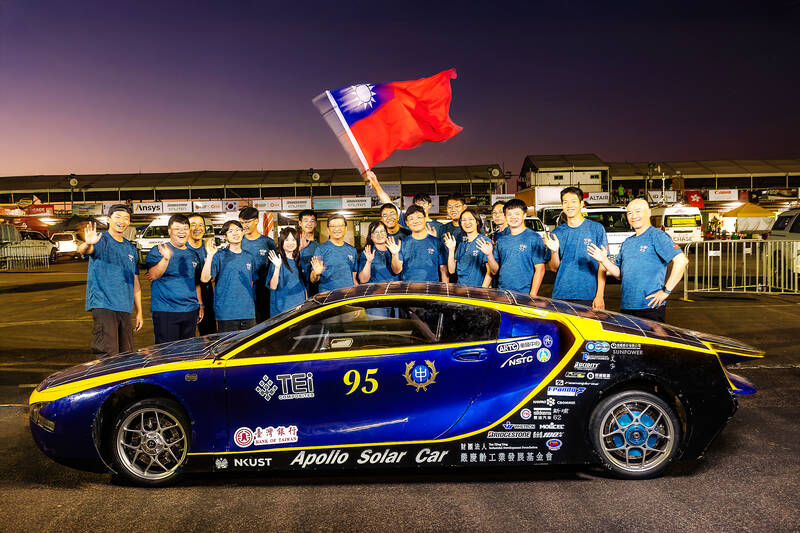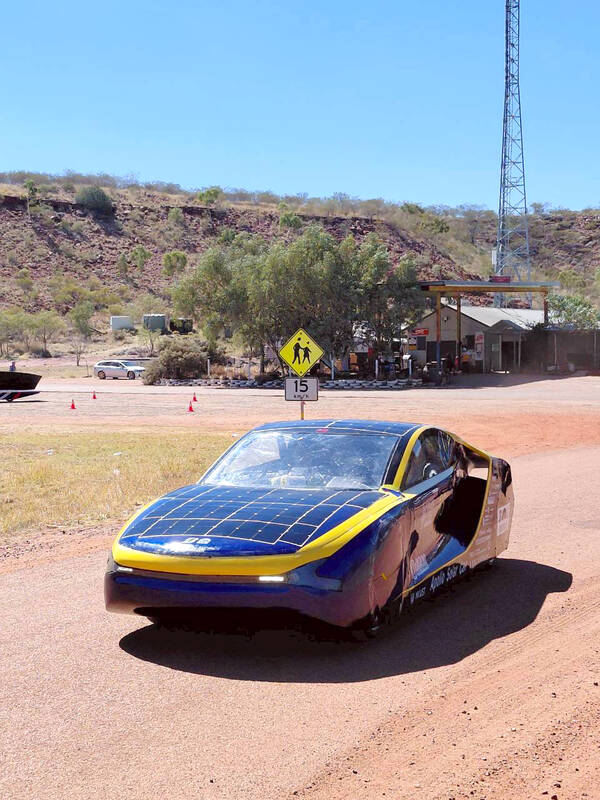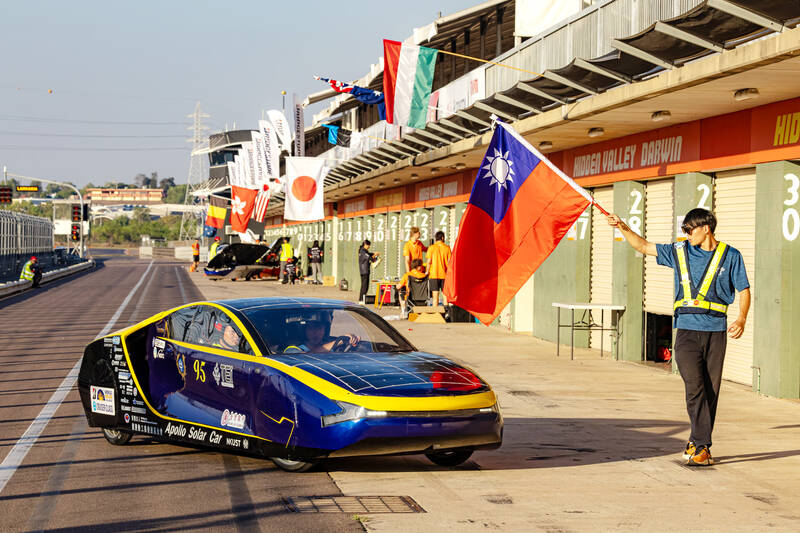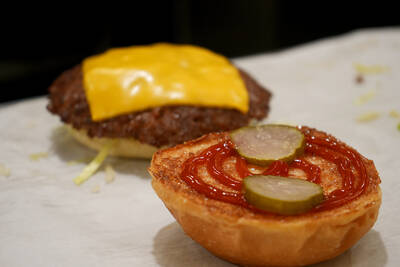Futuristic solar-powered cars have finished racing 3,000 kilometers across the rugged Australian Outback desert in the ultimate endurance competition. Running on enough power for a hair dryer, some reached speeds as high as 130 kilometers per hour and completed the trek in just four-and-a-half days.
This was the 17th Bridgestone World Solar Challenge (BWSC) since 1987, which is usually held every two years. It started on Aug. 24 in tropical Darwin and ended on Friday last week in the south coast city of Adelaide. The 34 entries included teams from around the world, with most of them being from universities and schools.
National Kaohsiung University of Science and Technology (NKUST) competed with its sleek car called “Apollo IX Plus.” This was the team’s eighth race across Australia.

Photo courtesy of Apollo Solar Car Team
Apollo IX was the fourth in its vehicle class to reach Adelaide.
GRUELING COMPETITION
Given that half of the cars were forced to retire from this grueling competition due to breakdowns and being unable to reach control stops in time, it was an admirable accomplishment for the NKUST team to even make it to Adelaide. Doubly so as the students chose to compete in a design class that came with extra challenges.

Photo courtesy of Apollo Solar Car Team
Looking like a vehicle out of a science fiction movie, the roof and front of the streamlined and low Apollo IX is covered with dark solar cells. The cells convert sunlight into electricity, which is stored in batteries to be drawn off as needed to run a high-efficiency motor built into one of the wheels.
For most teams, car designs evolve from the knowledge and skills developed from building and racing previous versions. However, for university teams like NKUST, the turnover of students every few years presents a special challenge.
“Because it is university education, research and development talent is difficult to keep at the school long term,” said Herchang Ay (艾和昌), team advisor and a professor at NKUST. “The biggest challenge is passing on the technology of the solar vehicle. We must maintain close cooperation with industry, especially the companies that our early team members are serving.”

Photo courtesy of Apollo Solar Car Team
Most of the vehicles in this race competed in the Challenger Class. Designed to sprint to the finish line, they tend to be sleeker and smaller.
CRUISER CLASS
In contrast, the Cruiser Class cars, like Apollo IX, are more practical looking and carry a driver and at least one passenger, and there must be space for a luggage compartment. This makes them larger, heavier and less aerodynamic than the leading Challenger cars, presenting extra challenges to reaching Adelaide in time. However, the NKUST team chose to enter this more demanding part of the competition.
“Believing that solar vehicles are the future of electric mobility, we joined the Cruiser Class to speed up commercialization and open new business opportunities,” Ay said.
The Cruiser vehicles demonstrate the practical possibilities of the technology showcased by solar racers. Competition judging considered sustainable and marketable design features.
This year’s race came with extra hurdles, making it even more difficult for Cruiser cars like Apollo IX.
Usually held in October, this year the race was run late last month, at the end of the Australian winter. Although this meant fewer extremely hot days, there was about 20 percent less sunshine to power the cars. Also, the maximum battery storage capacity was reduced.
This meant teams had to design cars that were even more energy efficient than previous models. They had to capture as much solar power as possible and use it wisely, relying less on energy stored in the batteries.
The team from NKUST believed they had met these needs with a practical and appealing design. On the race Web site, the team notes they had worked on “[r]edefining the product value of solar-powered new energy vehicles with a focus on commercialization, low aerodynamic drag, energy efficiency, mass producibility and innovative design aesthetics as the development goals for the Apollo IX vehicle model.”
It appears the team accomplished these goals.
“Throughout the race, many visitors called Apollo IX the ‘best-looking car powered by the Sun.’ It’s a key motivation for us to keep advancing toward a production-ready solar EV,” Ay said.
Four leading teams, including the winning Dutch team, Brunel, used an innovation that led to this year’s competition being called “the battle of the fins.”
A sharklike fin can be extended up from behind the canopy and turned like a sail to capture crosswinds and help stabilize the car.
The NKUST team might consider integrating such a device with its built-in diffuser, which assists with the air flow at the rear of the car to reduce drag.
CAMARADERIE
Ay said there was plenty of camaraderie among the teams in this friendly competition. For part of the race, the NKUST team was near the team from the Hong Kong Institute of Vocational Education. “Before each start [of the day] we often borrowed tools or parts from one another.”
“In addition, during scrutineering, Apollo IX was flagged because its seatbelts were past their service life, and finding professional-grade replacements in Darwin on short notice was extremely difficult. Fortunately, the University of Michigan and Tokai University [from Japan] stepped in and provided spare seatbelts so we could pass scrutineering. Michigan even donated theirs to us, which, as an alumnus, moved me deeply.”
The professor noted that Apollo IX managed to power through difficult conditions at the end, despite the smaller battery pack this year.
“On Aug. 29 (the final day of the race), we faced strong winds all day, prompting a delayed start by the organizers. And under rainy skies, Apollo IX, with a 15 kilowatt-hour battery pack, still covered more than 400 kilometers.”
There was more than wind to contend with in the Outback, not only while racing during the day, but also while camped at the roadside overnight.
“This event was held during the Australian winter, where the day-to-night temperature swing is huge: scorching in some places by day and bitterly cold at night. The weather can feel like all four seasons in a single day. It was truly a rare and memorable experience.”
Tom Simko participated in previous World Solar Challenges and served as a driver and advisor for the Queen’s University Solar Vehicle Team. He is an academic at RMIT University in Melbourne Australia.

Taiwan can often feel woefully behind on global trends, from fashion to food, and influences can sometimes feel like the last on the metaphorical bandwagon. In the West, suddenly every burger is being smashed and honey has become “hot” and we’re all drinking orange wine. But it took a good while for a smash burger in Taipei to come across my radar. For the uninitiated, a smash burger is, well, a normal burger patty but smashed flat. Originally, I didn’t understand. Surely the best part of a burger is the thick patty with all the juiciness of the beef, the

The ultimate goal of the Chinese Communist Party (CCP) is the total and overwhelming domination of everything within the sphere of what it considers China and deems as theirs. All decision-making by the CCP must be understood through that lens. Any decision made is to entrench — or ideally expand that power. They are fiercely hostile to anything that weakens or compromises their control of “China.” By design, they will stop at nothing to ensure that there is no distinction between the CCP and the Chinese nation, people, culture, civilization, religion, economy, property, military or government — they are all subsidiary

This year’s Miss Universe in Thailand has been marred by ugly drama, with allegations of an insult to a beauty queen’s intellect, a walkout by pageant contestants and a tearful tantrum by the host. More than 120 women from across the world have gathered in Thailand, vying to be crowned Miss Universe in a contest considered one of the “big four” of global beauty pageants. But the runup has been dominated by the off-stage antics of the coiffed contestants and their Thai hosts, escalating into a feminist firestorm drawing the attention of Mexico’s president. On Tuesday, Mexican delegate Fatima Bosch staged a

Would you eat lab-grown chocolate? I requested a sample from California Cultured, a Sacramento-based company. Its chocolate, not yet commercially available, is made with techniques that have previously been used to synthesize other bioactive products like certain plant-derived pharmaceuticals for commercial sale. A few days later, it arrives. The morsel, barely bigger than a coffee bean, is supposed to be the flavor equivalent of a 70 percent to 80 percent dark chocolate. I tear open its sealed packet and a chocolatey aroma escapes — so far, so good. I pop it in my mouth. Slightly waxy and distinctly bitter, it boasts those bright,